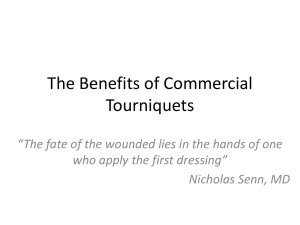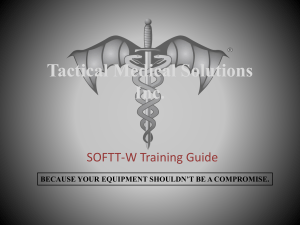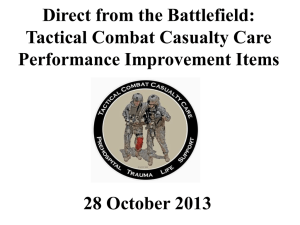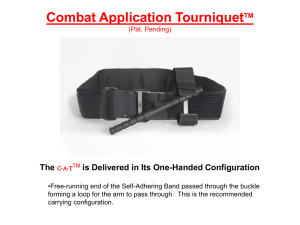Care Under Fire
advertisement
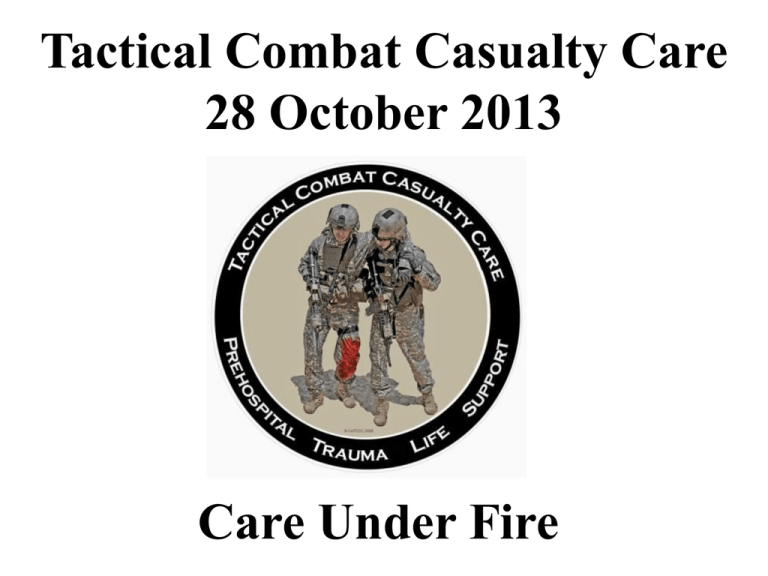
Tactical Combat Casualty Care 28 October 2013 Care Under Fire Objectives • • • DESCRIBE the role of firepower supremacy in the prevention of combat trauma. DEMONSTRATE techniques that can be used to quickly move casualties to cover while the unit is engaged in a firefight. EXPLAIN the rationale for early use of a tourniquet to control life-threatening extremity bleeding during Care Under Fire. Objectives • • DEMONSTRATE the appropriate application of the C-A-T to the arm and leg. EXPLAIN why immobilization of the cervical spine is not a critical need in combat casualties with penetrating trauma to the neck. Care Under Fire Guidelines 1. Return fire and take cover. 2. Direct or expect casualty to remain engaged as a combatant if appropriate. 3. Direct casualty to move to cover and apply self-aid if able. 4. Try to keep the casualty from sustaining additional wounds. Care Under Fire Guidelines 5. Casualties should be extricated from burning vehicles or buildings and moved to relative safety. Do what is necessary to stop the burning process. 6. Airway management is generally best deferred until the Tactical Field Care phase. Care Under Fire Guidelines 7. Stop life-threatening external hemorrhage if tactically feasible: – Direct casualty to control hemorrhage by selfaid if able. – Use a CoTCCC-recommended tourniquet for hemorrhage that is anatomically amenable to tourniquet application. – Apply the tourniquet proximal to the bleeding site, over the uniform, tighten, and move the casualty to cover. Care Under Fire • Prosecuting the mission and caring for the casualties may be in direct conflict. • What’s best for the casualty may NOT be what’s best for the mission. • When there is conflict – which takes precedence? • Scenario dependent • Consider the following example: Raid on Entebbe by ADM Bill McRaven • • • • • • • 27 June 1976 Air France Flight 139 hijacked Flown to Entebbe (Uganda) 106 hostages held in Old Terminal at airport 7 terrorists guarding hostages 100 Ugandan troops perimeter security Israeli commando rescue planned Raid on Entebbe by ADM Bill McRaven Rescue 4 July 1976 • Exit from C-130 in a Mercedes and 2 Land Rovers to mimic mode of travel of Idi Amin – the Ugandan dictator at the time • Israeli commandos dressed as Ugandan soldiers • Drove up to the terminal - shot the Ugandan sentry • Assaulted the terminal through 3 doors Raid on Entebbe by ADM Bill McRaven • LTC Netanyahu – the ground commander – shot in chest at the beginning of the assault • What should the corpsman or medic do? – Disengage from the assault? – Start an IV? – Immediate needle decompression of chest? Raid on Entebbe by ADM Bill McRaven As previously ordered, the three assault elements disregarded Netanyahu and stormed the building.” “At this point in the operation, there wasn’t time to attend to the wounded.” Do seconds really matter in combat? Ma’a lot Rescue Attempt by ADM Bill McRaven • • • • 15 May 1974 3 PLO terrorists take 105 hostages Schoolchildren and teachers When assault commenced, terrorists began killing hostages • 22 children killed, 56 wounded • The difference between a dramatic success and a disaster may be measured in seconds. Care Under Fire • If the firefight is ongoing - don’t try to treat your casualty in the Kill Zone! • Suppression of enemy fire and moving casualties to cover are the major concerns. Care Under Fire • Suppression of hostile fire will minimize the risk of both new casualties and additional injuries to the existing casualties. • The firepower contributed by medical personnel and the casualties themselves may be essential to tactical fire superiority. • The best medicine on the battlefield is Fire Superiority. Moving Casualties in CUF • If a casualty is able to move to cover, he should do so to avoid exposing others to enemy fire. • If casualty is unable to move and unresponsive, the casualty is likely beyond help and moving him while under fire may not be worth the risk. • If a casualty is responsive but can’t move, a rescue plan should be devised if tactically feasible. • Next sequence of slides shows the hazards of moving casualties before hostile fire is suppressed. 1) While under fire and without a weapon, Gunnery Sgt. Ryan P. Shane runs to Sgt. Lonnie Wells, to pull him to safety during USMC combat operations in Fallujah. 2) Gunnery Sgt Shane attempts to pull a fatally wounded Sgt Wells to cover. 3) Another Marine comes to help. 4) Gunnery Sgt. Shane (left) is hit by enemy fire. 5) Gunnery Sgt Shane, on ground at left, was hit by insurgent sniper fire. Casualty Movement Rescue Plan If you must move a casualty under fire, consider the following: – – – – – – – Location of nearest cover How best to move him to the cover The risk to the rescuers Weight of casualty and rescuer Distance to be covered Use suppression fire and smoke to best advantage! Recover casualty’s weapons if possible Types of Carries for Care Under Fire • • • • One-person drag with/without line Two-person drag with/without line SEAL Team Three Carry Hawes Carry One-Person Drag Two-Person Drag Video: Two-Person Drag Two-Person Drag Using Lines SEAL Team Three Carry (1) SEAL Team Three Carry (2) Hawes Carry Carries Practical How Not to Do It Burn Prevention in CUF • Remove casualty from burning vehicles or structures ASAP and move to cover. • Stop burning with any non-flammable fluids readily accessible, by smothering, or by rolling on the ground. Burn Prevention in CUF Wear fire-retardant Nomex gloves and uniform! Right hand of burn casualty spared by fire-resistant glove Fire-Resistant Army Combat Shirt The Number One Medical Priority in CUF Early control of severe hemorrhage is critical. – Extremity hemorrhage is the most frequent cause of preventable battlefield deaths. – Over 2500 deaths occurred in Vietnam secondary to hemorrhage from extremity wounds. – Injury to a major vessel can quickly lead to shock and death. – Only life-threatening bleeding warrants intervention during Care Under Fire. Question • How long does it take to bleed to death from a complete femoral artery and vein disruption? • Answer: – Casualties with such an injury can bleed to death in as little as 3 minutes Video: Femoral Artery Bleeding Care Under Fire The need for immediate access to a tourniquet in such situations makes it clear that all personnel on combat missions should have a CoTCCC-recommended tourniquet readily available at a standard location on their battle gear and be trained in its use. - Casualties should be able to easily and quickly reach their own tourniquet. Care Under Fire Where a tourniquet can be applied, it is the first choice for control of life-threatening hemorrhage in Care Under Fire. A Preventable Death Did not have an effective tourniquet applied bled to death from a leg wound Tourniquet Application • Apply without delay if indicated. • Both the casualty and the medic are in grave danger while a tourniquet is being applied in this phase – don’t use tourniquets for wounds with only minor bleeding. • The decision regarding the relative risk of further injury versus that of bleeding to death must be made by the person rendering care. Tourniquet Application • Non-life-threatening bleeding should be ignored until the Tactical Field Care phase. • Apply the tourniquet without removing the uniform – make sure it is clearly proximal to the bleeding site. • Tighten until bleeding is controlled. • May need a second tourniquet applied just above the first to control bleeding. • Don’t put a tourniquet directly over the knee or elbow. • Don’t put a tourniquet directly over a holster or a cargo pocket that contains bulky items. Anatomy of a TM C-A-T The Combat Application TourniquetTM (C-A-TTM) (Patent Pending) is a small and lightweight one-handed tourniquet that can completely occlude arterial blood flow in an extremity. Combat Application TourniquetTM The C-A-TTM is Delivered in Its One-Handed Configuration C-A-T™ One-Handed Application to an Arm Step 1: Insert the wounded extremity through the C-A-T™. C-A-T™ One-Handed Application to an Arm Step 2: Pull the Self-Adhering Band™ tight and securely fasten it back on itself. C-A-T™ One-Handed Application to an Arm Step 3: Adhere the band around the arm. Do not adhere the band past the clip. C-A-T™ One-Handed Application to an Arm Step 4: Twist the rod until the bleeding has stopped. C-A-T™ One-Handed Application to an Arm Step 5: Lock the rod in place in the Windlass ClipTM. C-A-T™ One-Handed Application to an Arm Hemorrhage is now controlled. C-A-T™ One-Handed Application to an Arm For added security, and always before moving a patient, proceed to secure the Windlass RodTM with the Windlass StrapTM. C-A-T™ One-Handed Application to an Arm Step 6: Adhere the Self-Adhering Band™ Over the Rod and continue around the extremity as far as it will go. C-A-T™ One-Handed Application to an Arm Step 7: Secure the rod and the band with the Windlass StrapTM. Grasp the strap, pull it tight, and adhere it to the opposite hook on the Windlass ClipTM. C-A-T™ One-Handed Application to an Arm The casualty is now ready for transport. Video: C-A-T™ One-Handed Application to an Arm Video courtesy North American Rescue C-A-T™ Two-Handed Application to a Leg Step 1: Route the Self-Adhering Band™ Around the leg. Pass the free-running end of the band through the inside slit of the friction adaptor buckle. C-A-T™ Two-Handed Application to a Leg Step 2: Pass the band through the outside slit of the buckle. C-A-T™ Two-Handed Application to a Leg Step 3: Pull the Self-Adhering Band™ tight and securely fasten the band back on itself. C-A-T™ Two-Handed Application to a Leg Step 4: Twist the rod until bright red bleeding has stopped. C-A-T™ Two-Handed Application to a Leg Step 5: Lock the rod in place in the Windlass ClipTM. C-A-T™ Two-Handed Application to a Leg Hemorrhage is now controlled. C-A-T™ Two-Handed Application to a Leg Step 6: Secure the rod with the strap. Grasp the Windlass StrapTM, pull it tight, and adhere it to the opposite hook on the Windlass ClipTM. C-A-T™ Two-Handed Application to a Leg The casualty is now ready for transport Video: C-A-T™ Two-Handed Application to a Leg Video courtesy North American Rescue Other Tourniquets The SOF® Tactical Tourniquet (SOF®TT) by Tactical Medical Solutions, Inc. Photo courtesy TMS, Inc. Other Tourniquets Emergency and Military Tourniquet (EMT™) by Delfi Medical Innovations, Inc. Photo courtesy Wafflephile/Wikipedia Impact of Tourniquet Use Kragh - Annals of Surgery 2009 • Ibn Sina Hospital, Baghdad, 2006 • Tourniquets are saving lives on the battlefield • Better survival when tourniquets were applied BEFORE casualties went into shock • 31 lives saved in this study by applying tourniquets prehospital rather than in the ED • Estimated 1000-2000 lives saved in war to date by tourniquets (data provided to Army Surgeon General) Safety of Tourniquet Use Kragh - Journal of Trauma 2008 • Combat Support Hospital in Baghdad • 232 patients with tourniquets on 309 limbs • CAT was best field tourniquet • No amputations caused by tourniquet use • Approximately 3% transient nerve palsies Examples of Extremity Wounds That Do NOT Need a Tourniquet Use a tourniquet ONLY for severe bleeding! Tourniquet Mistakes to Avoid! • • • • • • • • • Not using one when you should Using a tourniquet for minimal bleeding Putting it on too proximally Not taking it off when indicated during TFC Taking it off when the casualty is in shock or has only a short transport time to the hospital Not making it tight enough – the tourniquet should eliminate the distal pulse Not using a second tourniquet if needed Waiting too long to put the tourniquet on Periodically loosening the tourniquet to allow blood flow to the injured extremity * These lessons learned have been written in blood. * Tourniquet Pain • Tourniquets HURT when applied effectively • Does not necessarily indicate a mistake in application • Does not mean you should take it off! • Manage pain per TCCC Guidelines Questions? Tourniquet Practical Hemorrhage Control • Some wounds are located in places where a tourniquet cannot be applied, such as: – Neck – Axilla (armpit) – Groin • The use of a hemostatic agent (e.g., Combat Gauze) is generally not tactically feasible in CUF because of the requirement to hold direct pressure for 3 minutes. Airway – Will Cover in TFC No immediate management of the airway is anticipated while in the Care Under Fire phase. – Don’t take time to establish an airway while under fire. – Defer airway management until you have moved casualty to cover. – Combat deaths from compromised airways are relatively infrequent. – If casualty has no airway in the Care Under Fire phase, chances for survival are minimal. C-Spine Stabilization Penetrating head and neck injuries do not require C-spine stabilization – Gunshot wounds (GSW), shrapnel – In penetrating trauma, the spinal cord is either already compromised or is in relatively less danger than would be the case with blunt trauma. C-Spine Stabilization Blunt trauma is different! – Neck or spine injuries due to falls, fast-roping injuries, or motor vehicle accidents may require C-spine stabilization. – Apply only if the danger of hostile fire does not constitute a greater threat. Summary of Key Points • Return fire and take cover! • Direct or expect casualty to remain engaged as a combatant if appropriate. • Direct casualty to move to cover if able. • Try to keep the casualty from sustaining additional wounds. • Get casualties out of burning vehicles or buildings. Summary of Key Points • Airway management is generally best deferred until the Tactical Field Care phase. • Stop life-threatening external hemorrhage if tactically feasible. – Use a tourniquet for hemorrhage that is anatomically amenable to tourniquet application. – Direct casualty to control hemorrhage by selfaid if able. Questions? Questions? Scenario Based Planning • If the basic TCCC combat trauma management plan for Care Under Fire doesn’t work for your specific tactical situation – then it doesn’t work. • Scenario-based planning is critical for success. • Incorporate likely casualty scenarios into unit mission planning! • The following is one example. Convoy IED Scenario Convoy IED Scenario • Your element is in a five-vehicle convoy moving through a small Iraqi village. • Command detonated IED explodes under second vehicle. • Moderate sniper fire. • Rest of the convoy is suppressing sniper fire. Convoy IED Scenario • You are a medic in the disabled vehicle. • Person next to you has bilateral mid-thigh amputations. • Heavy arterial bleeding from the left stump. • Right stump has only mild oozing of blood. Convoy IED Scenario • Casualty is conscious and in moderate pain. • Vehicle is not on fire and is right side up. • You are uninjured and able to assist. Convoy IED Scenario First decision: • Return fire or treat casualty? – Treat immediate threat to life – Why? • Rest of convoy providing suppressive fire • Treatment is effective and QUICK • First action? – Tourniquet on stump with arterial bleed Convoy IED Scenario Next action? • Tourniquet on second stump? – Not until Tactical Field Care Phase – Not bleeding right now Next actions? • • • Drag casualty out of vehicle and move to best cover Return fire if needed Communicate info to team leader Questions? SOF® Tactical Tourniquet SOF®TT One-Handed Application to an Arm Step 1: Open the tourniquet, exposing the loop of webbing. Grasp the running end of the webbing near the buckle, and slide the tourniquet over the injured extremity. SOF®TT One-Handed Application to an Arm Step 2: Pull the webbing until the tourniquet is tight around the limb. SOF®TT One-Handed Application to an Arm Step 3: Twist the windlass until the bleeding stops. SOF®TT One-Handed Application to an Arm Step 4: To secure the windlass, latch either of its notched ends into one of the triangular rings on the tourniquet base. SOF®TT One-Handed Application to an Arm Step 5: Tighten the safety screw to prevent accidental loosening of the tourniquet while moving the casualty. The casualty is now ready for transport. SOF®TT Two-Handed Application to a Leg Step 1: Remove the webbing from the buckle. SOF®TT Two-Handed Application to a Leg Step 2: Position the tourniquet base on the injured limb above the wound. Route the webbing around the limb. SOF®TT Two-Handed Application to a Leg Step 3: Route the webbing through the buckle and pull until the tourniquet is tight. SOF®TT Two-Handed Application to a Leg Step 4: Tighten the windlass until the bleeding stops. SOF®TT Two-Handed Application to a Leg Step 5: To secure the windlass, lock either of its notched ends into one of the triangular rings on the tourniquet base. SOF®TT Two-Handed Application to a Leg Step 6: Tighten the safety screw to prevent accidental loosening of the tourniquet while moving the casualty. The casualty is now ready for transport.


